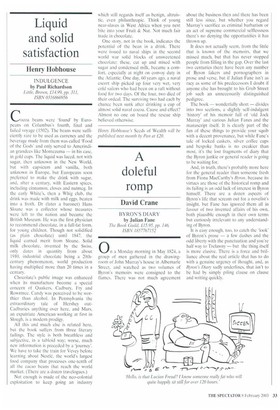Liquid and solid satisfaction
Henry Hobhouse
INDULGENCE by Paul Richardson Little, Brown, £14.99, pp. 311, ISBN 0316860956 Cocoa beans were 'found' by Europeans on Columbus's fourth, final and failed voyage (1502), The beans were sufficiently rare to be used as currency and the beverage made from them was called 'Food of the Gods' and only served to Amerindian grandees like Montezuma — in his case, in gold cups. The liquid was laced, not with sugar, then unknown in the New World, but with capsicum and vanilla, both unknown in Europe, but Europeans soon preferred to make the drink with sugar, and, after a century, with Eastern spices, including cinnamon, cloves and nutmeg. In the early White's, then a Whig club, the drink was made with milk and eggs, beaten into a froth. Dr (later a baronet) Hans Sloane was a collector whose treasures were left to the nation and became the British Museum. He was the first physician to recommend chocolate, in a full-fat form, for young children. Though not solidified (as plain chocolate) until 1847, the liquid earned merit from Sloane. Solid milk chocolate, invented by the Swiss, only dates in quantity from about 1910, industrial chocolate being a 20thcentury phenomenon, world production having multiplied more than 20 times in a century.
Chocolate's public image was enhanced when its manufacture become a special concern of Quakers, Cadbury, Fry and Rowntree. Candy was perceived to be worthier than alcohol. In Pennsylvania the extraordinary tale of Hershey outCadburies anything over here, and Mars, an expatriate American working at first in Slough, is a modern prodigy.
All this and much else is related here, but the book suffers from three literary failings. The style is both breathless and subjective, in a tabloid way; worse, much new information is preceded by a 'journey'. We have to take the train for Vevey before learning about Nestle, the world's largest food company that processes one-tenth of all the cacao beans that reach the world market. (There are a dozen travelogues.) Not enough is made of the neo-colonial exploitation to keep going an industry which still regards itself as benign, altruistic, even philanthropic. Think of young near-slaves in West Africa when you next bite into your Fruit & Nut. Not much fair trade in chocolate.
One story, not in the book, indicates the potential of the bean in a drink. There were issued to naval ships in the second world war solid blocks of unsweetened chocolate; these, cut up and mixed with sugar and condensed milk, became a comfort, especially at night on convoy duty in the Atlantic. One day, 60 years ago, a naval escort ship picked up four very wet, very cold sailors who had been on a raft without food for two days. Of the four, two died of their ordeal. The surviving two had each by chance been sunk after drinking a cup of almost solid naval cocoa. Cause and effect? Almost no one on board the rescue ship believed otherwise. about the business then and there has been still less since, but whether you regard Murray's sacrifice as criminal barbarism or an act of supreme commercial selflessness there's no denying the opportunities it has thrown up.
It does not actually seem, from the little that is known of the memoirs, that we missed much, but that has never stopped people from filling in the gap. Over the last two centuries there have been any number of Byron fakers and pornographers in prose and verse, but if Julian Fane isn't as racy as some of his predecessors I doubt if anyone else has brought to his Grub Street job such an unnecessarily distinguished pedigree.
The book — wonderfully short — divides into two sections, a slightly self-indulgent 'history' of his memoir full of .old Jock Murray' and various Julian Fanes and the manuscript itself. It is clearly part of the fun of these things to provide your squib with a decent provenance, hut while Fane's tale of locked caskets, silver coffee cups and bespoke banks is no creakier than most, it's the lost fragments of diary that the Byron junkie or general reader is going to be waiting for.
And, in truth, there's probably more here for the general reader than someone fresh from Fiona MacCarthy's Byron, because its virtues are those of the historical romp and its failing is an odd lack of interest in Byron himself. There are a dozen aspects of Byron's life that scream out for a novelist's insight. but Fane has ignored them all in favour of two invented affairs of his own, both plausible enough in their own terms but curiously irrelevant to any understanding of Byron.
It is easy enough, too, to catch the look' of Byron's prose — a few dashes and the odd liberty with the punctuation and you're half way to Trelawny — but the thing itself is more elusive. There is a force and brilliance about the real article that has to do with a genuine urgency of thought, and, as Byron's Diary sadly underlines, that isn't to be had by simply piling clause on clause and writing quickly.


























































 Previous page
Previous page